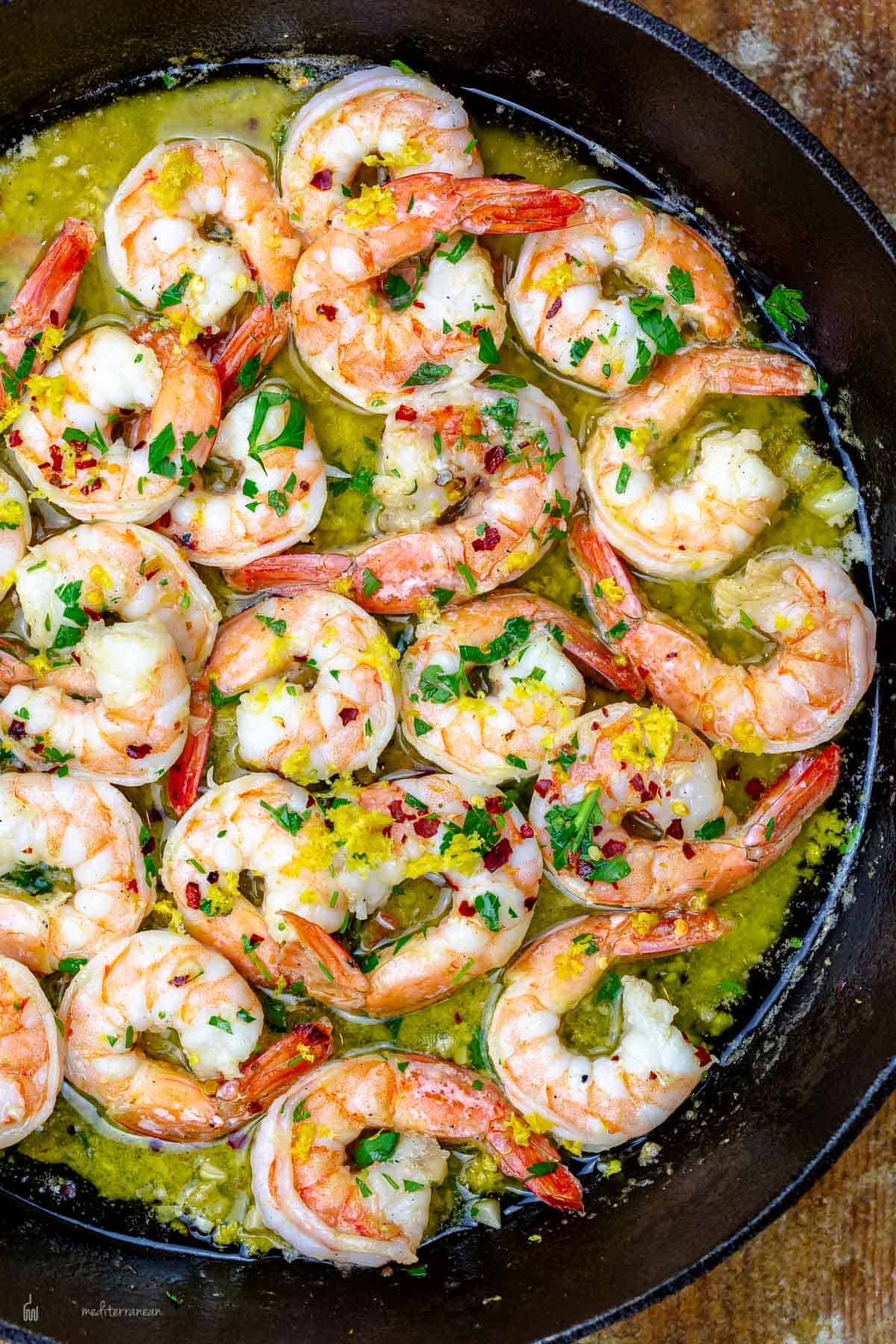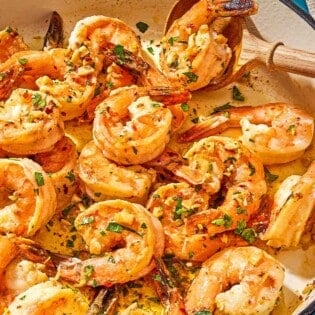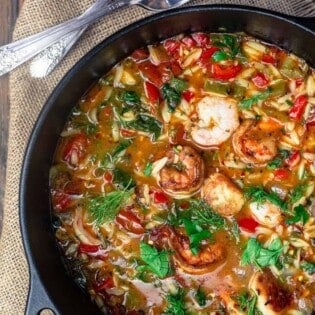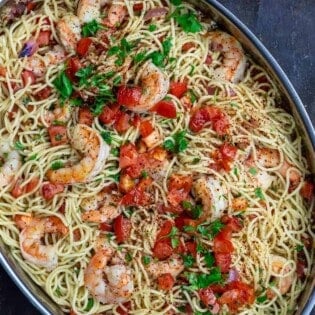Everything you need to know about America’s favorite seafood, including how to buy, prepare, and cook shrimp perfectly every time.

There may be other fish in the sea, but Americans prize one seafood above all: shrimp. This curly crustacean has been the most popular seafood in the United States for years.
Versatile and requiring very little cooking time, shrimp is as great for a weeknight dinner as it is for a special occasion, and it appears on kitchen tables and banquet buffets alike, whether it’s fried, boiled, or served over pasta, or skewered on kebabs.
Table of Contents
- What Are Shrimp, Exactly?
- Types of Shrimp
- How to Buy Shrimp?
- Small, Jumbo, Colossal? A Size Guide for Buying Shrimp
- Is Shrimp Good for You? Why?
- How Long to Cook Shrimp?
- How to Defrost Shrimp?
- How to Devein and Peel?
- How to Store Shrimp?
- Transform Shells and Tails into Stock
- Now Let’s Cook Some Shrimp!
- Add a Sprinkle of Aleppo to Your Favorite Shrimp Dishes!

What Are Shrimp, Exactly?
Shrimp are crustaceans, which means they’re shellfish with hard exteriors and legs. More specifically, they’re decapods, which means they have 10 legs. Other familiar decapod crustaceans include lobster and crabs.
Types of Shrimp
There are dozens of kinds of shrimp. Here are some of the most commonly sold shrimp varieties in the United States:
- Brown Shrimp: Mild in flavor and firm in texture, these shrimp come from warmer waters, like the Gulf of Mexico and the Atlantic. Their tail has a purple hue.
- White Shrimp: White shrimp have a sweeter flavor and softer texture than brown shrimp and are found in warmer, muddier waters, including the Gulf of Mexico, the Atlantic, Latin America, Thailand, and China. Their tails have a green tint.
- Pink Shrimp: These shrimp are sweet and firm, and may have a darker blue-colored tail. Despite their name, their bodies may be white or gray in color. They’re typically the most inexpensive option.

How to Buy Shrimp?
Buckle up. There are a lot of options. The good news is, it’s all pretty straightforward and you’ll be a shrimp-purchasing pro by the end.
Frozen shrimp is easy to find in the supermarket, and there’s nothing wrong with buying frozen. More on that below. You can also find frozen or fresh shrimp at the fishmonger, and you may even encounter live shrimp at some fish stores.
Fresh vs Frozen
Most shrimp you see, whether it’s labeled “fresh” or “frozen,” has been flash-frozen right after being caught. If you see fresh shrimp at the supermarket or fish store, it may simply have been thawed. So don’t turn your nose up or shy away from the clearly frozen kind. It’s easy to bring to room temperature for cooking, and it will stay in good shape in the freezer for up to three to six months.
Head On or Off?
Most of the time, you’ll find headless shrimp. They’ve had their heads removed just before shipping, which keeps their bodies firmer.
Head-on shrimp, while special, can lead to mushier bodies if they sit for too long. If you happen to be buying live or definitely fresh shrimp with the head on from a fish-mongerer, enjoy the briny juice that comes out once you’ve cooked. Twist of the head and either suck the juice if you’re ready to eat, or use it in your recipe if you’re still cooking.
Headless shrimp makes for quick and easy cooking in all manner of recipes. If you’re going head-on, grilling is a great method.
Peeled or Unpeeled
The decision to buy shrimp with the shell on or off depends on a few things. How much you want to spend, value convenience, and value control over the final product.
Shrimp that has the shell in-tact will be the cheapest option and give the home cook the opportunity to peel carefully, while pre-peeled shrimp will be more expensive but runs the risk of getting mishandled.
If buying shrimp with the shell on, save the shells to make shellfish stock. Freeze the stock and when you’re ready use it in your favorite recipes like this Italian American seafood stew called Cioppino.
How to Devein Shrimp
Likewise, the decision to buy deveined shrimp or not depends on budget and the convenience factor.
The shrimp vein isn’t a vein at all but the digestive tract, and removing it is a personal preference. Removing it calls for using a small knife to slice into the shrimp’s back and pull the digestive tract out, which can be time-consuming if you’re dealing with a large quantity of smaller shrimp.
Buy deveined shrimp if you want to spend more money and save time. You can also buy shell-on deveined shrimp, which allows you to keep the flavor benefits of the shell.

Small, Jumbo, Colossal? A Size Guide for Buying Shrimp
When you see numbers on a bag of shrimp, they refer to the number of shrimp per pound. The smaller the shrimp, the more there will be per pound. Though numbers may vary, here’s a guide from Fulton Fish Market:
- Small: 71-90 per pound
- Medium: 41-50 and 51-60 per pound
- Large: 31-40 per pound
- Jumbo: 21-25 per pound and 26-30 per pound
- Colossal: 16-20 per pound
Is Shrimp Good for You? Why?
Shrimp is high in protein, low in calories, low in saturated fat and high in Omega-3 fatty acids, which makes it appealing to many people in terms of nutrition.
The USDA says that a three-ounce portion of shrimp has almost 20 grams of protein (39 percent of a daily diet) and only 100 calories.
Shrimp, however, is also high in cholesterol. That same three ounce portion contains 60 percent of one’s daily allotment, which is even more than that of red meat. Even still shrimp and its health benefits are debated by the medical community.
In an article published in Mayo Clinic Proceedings, a scientific peer-reviewed publication for physicians, doctors evaluated a study where consumption of shrimp by individuals with cardiac concerns still had positive outcomes.
“… despite the high cholesterol content, consumption of shrimp was associated with an overall favorable impact on lipid levels … leading to a net positive effect on total cholesterol this discrepancy has been attributed to the high omega-3 content and extremely low saturated fat levels in shrimp.”
Depending upon who you talk to, the high cholesterol in shrimp is balanced by low saturated fat (something shrimp has on beef) and high omega-3s. If cholesterol is an issue, talk with your doctor, but for the most part shellfish is a healthy choice.

How Long to Cook Shrimp?
There are, no surprise, many ways to cook shrimp. Some favorite methods include steaming, simmering away in soup, sauteing, and grilling.
The biggest risk is overcooking shrimp, so err on the side of less versus more time over the heat. Remember if you remove it from the heat source, the seafood will keep cooking for a little while.
- Don’t be afraid if the shrimp hasn’t turned completely pink when you remove it from the heat.
- If you plan to add shrimp into a soup or stew, a slight white or gray color is actually preferable, because it will definitely finish cooking in the hot liquid.
- If you aren’t doing a second round of cooking, the residual heat of the cooking vessel and surrounding shrimp will coax the color to the finish line.
How to Steam Shrimp: If you’re steaming, cook one pound of shrimp for 4-6 minutes, bearing in mind that smaller shrimp will steam faster than bigger shrimp.
How to Boil Shrimp: If boiling, cook the shrimp in the rapid water for just 1-3 minutes, depending on the size of the shrimp.
How to Saute Shrimp: If sauteing shrimp in a pan–say, for shrimp and polenta–cook for 3-5 minutes, or 1-2 minutes, depending on the size of the shrimp. Then flip and turn, and cook for 1-2 minutes more if the shrimp is large enough and needs it.
Alternatively, turn off the heat and cover for one minute if the shrimp needs just a little more heat. This residual heat method is a great way to slow the cooking and make sure the crustaceans don’t turn rubbery.
How to Grilling or Broil Shrimp: If grilling or broiling shrimp, cook it for 2-3 minutes per side.

How to Defrost Shrimp?
Defrosting shrimp is almost too easy. Simply place it in a bowl of cool water for 20-45 minutes. If you’re in a hurry, you can place the shrimp directly in the water and they’ll be ready in closer to 20 minutes.
Just keep an eye on them, because you don’t want them to sit in the water any longer than they have to. And make sure the water is cool, not warm. If you have more time, place the bag in which they’re packaged or a ziploc bag into the water. And if you’re a planner (congrats!) and have a lot of time, you can let frozen shrimp thaw in the refrigerator for a day before cooking.

How to Devein and Peel?
Deveining shrimp sounds like an annoying chore, and it can definitely be time-consuming if you’ve got a lot of shrimp on your hands, but it’s not too bad once you get the hang of it. (Some might even call it satisfying!) You can also devein shrimp with the shell on or off. Using a sharp knife, make a shallow slice down the middle of the shrimp’s back and use the tip of the knife to lift out the digestive tract.
As for peeling, it’s also pretty satisfying. If the head is on and you wish to remove it, hold and twist it to remove it. Next, remove the legs by giving them a quick yank. Now the shell should come off relatively easily by pulling up, starting from the head’s side, and unwrapping the shell from the body. You might need to use your thumb to negotiate a little space between the shell and the flesh before pulling and unwrapping. You can also use kitchen shears to cut open the shell.
How to Store Shrimp?
If you aren’t going to cook it right away, you can store frozen shrimp in the freezer (go figure!) for up to three to six months. If you plan to use frozen shrimp within a few days or if you’ve bought fresh shrimp, it will keep in the refrigerator for one to two days.

Transform Shells and Tails into Stock
Don’t throw shrimp shells away! Hang onto the heads and tails, too! Shrimp shells, heads, and tails are packed with flavor and make a great base for soups and sauces, and coaxing maximum flavor out of these discarded items doesn’t take very long either—unlike using, say, a chicken carcass to make chicken stock, which takes hours. (In other words, it’s a no brainer.)
To use shrimp shells, heads, or tails, follow these simple steps:
- Rinse heads under cool running water.
- Toss whatever you have into a saucepan and pour in just enough water to cover the shells.
- If you have other aromatics, like an onion, vegetable scraps, or herb stems, you can throw those in.
- Simmer for five minutes or 10 at most if you have a lot of shells. Strain and use as a stock for soup, risotto, or shrimp and rice; or reduce for sauces.
Now Let’s Cook Some Shrimp!
Browse all Mediterranean recipes.
Visit Our Shop.
Add a Sprinkle of Aleppo to Your Favorite Shrimp Dishes!
So much flavor and just the right amount of heat.








As to cleaning frozen shrimp..
I go though around 3-4 bags of unshelled raw shrimp per month.
To defrost I simply place them in a colander, run (spray) warm water over, take out, peel. With medium shrimp I don’t devein (takes far too much time) and no restaurant i now does this with medium sized. Takes around 5 minutes…